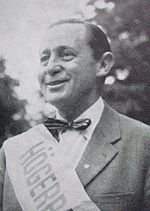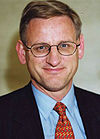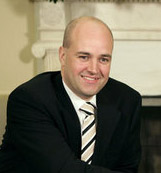Moderate Party: Difference between revisions
Undo |
Rescuing 1 sources and tagging 0 as dead. #IABot (v1.6.2) |
||
| Line 715: | Line 715: | ||
{{Commons category|Moderata samlingspartiet}} |
{{Commons category|Moderata samlingspartiet}} |
||
*{{official website}} {{sv icon}} |
*{{official website}} {{sv icon}} |
||
*[http://www.riksdagen.se/templates/R_SubStartPage____12076.aspx The Moderate Party], at the [[Parliament of Sweden|Swedish parliament]]'s website |
*[https://web.archive.org/web/20070209182955/http://www.riksdagen.se/templates/R_SubStartPage____12076.aspx The Moderate Party], at the [[Parliament of Sweden|Swedish parliament]]'s website |
||
{{Moderate Party}} |
{{Moderate Party}} |
||
Revision as of 08:19, 3 February 2018
Moderate Party Moderata samlingspartiet | ||
|---|---|---|
County councils[4] 339 / 1,597 | ||
| Municipal councils[5] | 2,435 / 12,780 | |
| Website | ||
| www | ||
The Moderate Party (Swedish: Moderata samlingspartiet, M: "Moderate Unity Party", commonly referred to in Swedish as Moderaterna: "Moderates") is a liberal-conservative[6][7][8][9] political party in Sweden.
The party was founded in 1904 as the General Electoral League by a group of
Following minor roles in centre-right governments, the Moderates became the leading opposition party to the
Following the
The Moderate Party is a full member of the
History
General Electoral League (1904–1938)

The party was founded on 17 October 1904 in a restaurant called Runan in
At first the party was clearly
From the beginning of the 20th century social democracy and the labour movement rose to replace liberalism as the major political force for radical reforms. The Moderate Party intensified its opposition to socialism during the leadership of Lindman—the importance of continuance and strengthening national business were cornerstones. But at the same time, recent social issues gained significant political attention; by appeasing the working class, the party also hoped to reduce the threat of revolutionary tendencies. During the governments led by Lindman, several reforms for social progress were made, and it was his first government that initiated the public state pension.

In the 1920s the Swedish right slowly started to move towards a
The 1930s saw the party in conflict over how to relate to the rising threat of
National Organization of the Right (1938–1952)
The party participated in the
In 1934 the Social Democrats formed a new government, and except for the World War II era, would stay in power until 1976. From having been a ruling party, the General Electoral League turned into a bastion of right-wing opposition, and in 1938 it was renamed the National Organization of the Right (Swedish: Högerns riksorganisation), a name that would stay until 1952. Outside Sweden the party was typically called the Conservative Party.
After the Second World War, the party gradually lost support and the
The Rightist Party (1952–1969)

At the beginning of the 1950s, the party re-emerged after being renamed the Rightist Party (
The party had significant success in the elections during the 1950s and became the largest party of the opposition in 1958. But the next decade brought changes to the political climate of Sweden. The
Moderate Party (1969–present)

The party was increasingly seen as extremist, and in hopes of changing its image, it changed its name to the Moderate Coalition Party (Swedish: Moderata Samlingspartiet, generally just referred to as Moderaterna) in 1969, or just the Moderate Party.
In 1970 Gösta Bohman was elected leader of the Moderate Party. During his leadership the party continued its gradual movement from nationalist traditionalist conservatism towards internationalist liberal conservatism, calling for Swedish membership in the EEC since the 1960s and in practice adopting most policies affiliated with classical liberalism. It also adopted a much more liberal social outlook, which was seen as a key factor in the foundation of the Christian Democratic Gathering in 1964, a socially conservative party. Bohman proved a successful leader, and helped lead the non-socialist opposition to victory in the 1976 election.
The Moderate Party joined the government under Thorbjörn Fälldin, with Gösta Bohman as Minister of Economy. The non-socialist parties managed to remain in power until 1982 in different constellations, but the election of 1979 again made the Moderate Party become the second party after the Social Democrats, a position it has held since then. Gösta Bohman was in 1981 replaced by Ulf Adelsohn.
In 1986
The party gained votes in 1994, but the governing coalition lost its majority. Bildt stayed on as the Moderate Party leader, failing to unite with the
Prior to the
In the
Reinfeldt is the first centre-right Prime Minister since the
In the
In the
Ideology and political positions

The Moderate Party states that its ideology is a mix of liberalism and conservatism, and corresponds to what is called liberal conservatism. The term liberalism is in Sweden and most of Europe not used in the way that it is currently used in the United States to denote modern liberals and progressives, but is closer to the traditional meaning of classical liberalism.
The Party supports free markets and personal freedom and has historically been the essential force for privatisation, deregulation, lowering tax rates, and a reduction of the public-sector growth rate.[17] Other issues emphasized by the party are such as actions against violent crime and sex crime, increasing and promoting the value of working, and quality in the educational system. The party supports same-sex marriage in Sweden and Sweden's membership in the European Union.
The party campaigned for changing currency to the Euro in the 2003 referendum. The Party was still in favor of the Euro as of 2013, but expressed that the issue of a membership of the Eurozone will not be relevant until the member states have met certain strict requirements set up by the party, for example regarding budget deficits.[18]
After
With the ascension of
The party is in favour of Swedish membership of
Voter base
|
|
The table on the left shows the Moderate Party's percentage of votes and difference compared to the overall result among some selected groups in the
The table on the right shows the party's percentage of votes and difference compared to the overall result in the 2010 parliamentary election by geographic
Those groups/areas where the party's support is higher than among the overall population are marked in green, while those groups/areas where the party's support is lower than among the overall population are marked in red.
As shown from the table, the five groups where the Moderate Party has its highest level of support are:
Geographically, the Moderate Party has its highest level of support in the urban areas of
The Moderate Party voters ranked the following issues as the five most important for their decision in the 2010 election:[27]
- Swedish economy
- Employment
- Private economy
- Schools and education
- Taxes
The Moderate Party also has the largest share of voters who identify as "right-wing"; 83% of the party's voters identify as "right-wing", 2% as "left-wing" and 14% as "neither right-wing nor left-wing".[27]
Furthermore, the Moderate Party, along with the Centre Party, also has the largest share of voters (83%) who say that they have "big/relatively big confidence in Swedish politicians" (average was 70%).[27]
Electoral history

Parliament (Riksdag)
| Election year | # of overall votes |
% of overall vote |
# of overall seats won |
+/– | Government |
|---|---|---|---|---|---|
1958
|
750,332 | 19.5 (#2) | 45 / 233
|
in opposition | |
1960
|
704,365 | 16.6 (#3) | 39 / 233
|
in opposition | |
1964
|
582,609 | 13.7 (#4) | 33 / 233
|
in opposition | |
1968
|
621,031 | 12.9 (#4) | 32 / 233
|
in opposition | |
1970
|
573,812 | 11.5 (#4) | 41 / 350
|
in opposition | |
1973
|
737,584 | 14.3 (#3) | 51 / 350
|
in opposition | |
1976
|
847,672 | 15.6 (#3) | 55 / 349
|
in coalition | |
1979
|
1,108,406 | 20.3 (#2) | 73 / 349
|
in coalition | |
1982
|
1,313,337 | 23.6 (#2) | 86 / 349
|
in opposition | |
1985
|
1,187,335 | 21.3 (#2) | 76 / 349
|
in opposition | |
1988
|
983,226 | 18.3 (#2) | 66 / 349
|
in opposition | |
1991
|
1,199,394 | 21.9 (#2) | 80 / 349
|
in coalition | |
1994
|
1,243,253 | 22.4 (#2) | 80 / 349
|
in opposition | |
1998
|
1,204,926 | 22.9 (#2) | 82 / 349
|
in opposition | |
2002
|
791,660 | 15.1 (#2) | 55 / 349
|
in opposition | |
2006
|
1,456,014 | 26.2 (#2) | 97 / 349
|
in coalition | |
2010
|
1,791,766 | 30.1 (#2) | 107 / 349
|
in coalition | |
2014
|
1,403,630 | 23.2 (#2) | 84 / 349
|
in opposition |
European Parliament
| Election year | # of overall votes |
% of overall vote |
# of overall seats won |
+/– |
|---|---|---|---|---|
1995
|
621,568 | 23.2 (#2) | 5 / 22
|
|
1999
|
524,755 | 20.7 (#2) | 5 / 22
|
|
2004
|
458,398 | 18.3 (#2) | 4 / 19
|
|
2009
|
596,710 | 18.8 (#2) | 4 / 18 4 / 20
|
|
2014
|
507,488 | 13.7 (#3) | 3 / 20
|
Organization
The party is organised on national, county and municipal level. Currently the party has around 600 local party associations and 26 county or city associations
In December 2009 the party's reported membership was 55,612 people, the second largest membership after the Social Democrats.[1]
Affiliated organizations
The Moderate Party has the following affiliated groups and organizations:
- Moderate Youth League (Moderata ungdomsförbundet, MUF), organizes young members
- Moderate Seniors (Moderata seniorer), organizes senior members
- Moderate Women (Moderatkvinnorna), organizes female members
- Open Moderates (Öppna moderater), organizes LGBT members
Leaders
Chairpersons
- Gustaf Fredrik Östberg, 1904–1905[31]
- Axel G. Svedelius, 1905–1906[31]
- Hugo Tamm, 1907[31]
- Gustaf Fredrik Östberg, 1908–1912[31]
- Arvid Lindman, 1912–1935[31]
- Gösta Bagge, 1935–1944[31]
- Fritiof Domö, 1944–1950[31]
- Jarl Hjalmarson, 1950–1961[31]
- Gunnar Heckscher, 1961–1965[31]
- Yngve Holmberg, 1965–1970[31]
- Gösta Bohman, 1970–1981[31]
- Ulf Adelsohn, 1981–1986[31]
- Carl Bildt, 1986–1999[31]
- Bo Lundgren, 1999–2003[31]
- Fredrik Reinfeldt, 2003–2015[31]
- Anna Kinberg Batra, 2015–2017[31]
- Ulf Kristersson, 2017–present[31]
First deputy party chairpersons (since 1935)
- Bernhard Johansson i Fredrikslund, 1935
- Martin Skoglund i Doverstorp, 1935–1956
- Leif Cassel, 1956–1965
- Gösta Bohman, 1965–1970
- Staffan Burenstam Linder, 1970–1981
- Lars Tobisson, 1981–1999
- Chris Heister, 1999–2003
- Gunilla Carlsson, 2003–2015
- Peter Danielsson, 2015–present
Second deputy party chairpersons (since 1935)
- Karl Magnusson i Skövde, 1935
- Fritiof Domö, 1935–1944
- Jarl Hjalmarson, 1944–1950
- Knut Ewerlöf, 1950–1958
- Gunnar Heckscher, 1958–1961
- Rolf Eliasson, 1961–1965
- Yngve Nilsson i Trobro, 1965–1970
- Eric Krönmark, 1970–1981
- Ella Tengbom-Velander, 1981–1986
- Ingegerd Troedsson, 1986–1993
- Gun Hellsvik, 1993–1999
- Gunilla Carlsson, 1999–2003
- Kristina Axén Olin, 2003–2009
- Beatrice Ask, 2009–2015
- Elisabeth Svantesson, 2015–present
Party secretaries (since 1949)
- Gunnar Svärd, 1949–1961
- Yngve Holmberg, 1961–1965
- Sam Nilsson, 1965–1969
- Bertil af Ugglas, 1969–1974
- Lars Tobisson, 1974–1981
- Georg Danell, 1981–1986
- Per Unckel, 1986–1991
- Gunnar Hökmark, 1991–1999
- Johnny Magnusson, 1999–2003
- Sven Otto Littorin, 2003–2006
- Per Schlingmann, 2006–2010
- Sofia Arkelsten, 2010–2012
- Kent Persson, 2012–2015
- Tomas Tobé, 2015–2017
- Anders Edholm, 2017
- Gunnar Strömmer, 2017–
National ombudsmen (1909–1965)
- Gustaf Gustafsson, 1909–1913
- Karl Hammarberg, 1913–1915
- Jonas Folcker, 1915–1920
- Lennart Kolmodin, 1920–1949
- Nils Hellström, 1949–1965
Prime Ministers
- Christian Lundeberg, 1905[31]
- Arvid Lindman, 1906–1911[31]
- Carl Swartz, 1917[31]
- Ernst Trygger, 1923–1924[31]
- Arvid Lindman, 1928–1930[31]
- Carl Bildt, 1991–1994[31]
- Fredrik Reinfeldt, 2006–2014[31]
See also
- Alliance for Sweden
- Politics of Sweden
- Prime Minister of Sweden
- Government of Sweden
- Parliament of Sweden
- Elections in Sweden
- Moderate Women's League of Sweden
References
- ^ a b Cederholm, Robert; Eliasson, Anders (15 March 2010). "Partierna tappar medlemmar". Sveriges Television. Archived from the original on 15 May 2011. Retrieved 7 October 2010.
{{cite news}}: Unknown parameter|deadurl=ignored (|url-status=suggested) (help) - ^ http://www.parties-and-elections.eu/sweden.html Sweden. Parties and Elections in Europe.
- ISBN 9783642413445.
- ^ "2014: Val till landstingsfullmäktige - Valda", Valmyndigheten, 2014-09-28
- ^ "2014: Val till kommunfullmäktige - Valda", Valmyndigheten, 2014-09-26
- ISBN 978-0-415-38360-8.
- ISBN 978-1-84844-135-4.
- ISBN 978-0-85745-270-2.
- ISBN 978-0-85745-777-6.
- ^ "Det konservativa partiet gick bakåt ända fram till 1950-talet, nu med namnet Högern (1934–52) och Högerpartiet (1952–69)." which translates approximately to "The conservative party decreased all the way until the 1950's, now under the name The Right (1934-52) and The Right (Wing) Party (1952-69)" - at [1]
- ^ Tandstad, Bent (18 September 2006). "Ein ny æra i svensk politikk". NRK.
- ISBN 0-271-04344-X.
- ^ "Archived copy". Archived from the original on 1 July 2014. Retrieved 2013-08-27.
{{cite web}}: Unknown parameter|deadurl=ignored (|url-status=suggested) (help)CS1 maint: archived copy as title (link) - ^ "Archived copy". Archived from the original on 4 May 2016. Retrieved 25 May 2016.
{{cite web}}: Unknown parameter|deadurl=ignored (|url-status=suggested) (help)CS1 maint: archived copy as title (link) - ISBN 91-7566-429-1.
- ISBN 978-1-135-26140-5.
- ISBN 978-1-134-27282-2.
- ^ Hennel, Lena (30 March 2013). "M skjuter euron på framtiden". Svenska Dagbladet. Stockholm: Handelsbolaget Svenska Dagbladet AB & Co. Retrieved 2 January 2017.
- ^ [2] Archived 29 October 2007 at the Wayback Machine
- ^ Stenberg, Ewa; Eriksson, Karin (9 July 2016). "De nya hårda moderaterna". Dagens Nyheter (in Swedish). Stockholm: AB Dagens Nyheter. Retrieved 1 January 2017.
- ^ Lönnaeus, Olle (17 October 2015). "Moderaterna skärper sin migrationspolitik". Sydsvenskan (in Swedish). Malmö: Sydsvenska Dagbladets AB. Retrieved 1 January 2017.
- ^ Olsson, Hans (14 April 2016). "Moderaterna vill begränsa stödet för flyktingar". Dagens Nyheter (in Swedish). Stockholm: AB Dagens Nyheter. Retrieved 1 January 2017.
- Göteborgsposten (in Swedish). Gothenburg: Stampen Local Media AB. Retrieved 1 January 2017.
- ^ My, Rohwedder (17 February 2015). "Moderaterna vill höja anslagen till försvaret". Sveriges Radio (in Swedish). Stockholm: Sveriges Radio AB. Retrieved 1 January 2017.
- ^ Bjurbo, Peter (28 September 2016). "Moderaterna ställer sig bakom värnplikt". Sveriges Radio (in Swedish). Stockholm: Sveriges Radio AB. Retrieved 1 January 2017.
- ^ Gummesson, Jonas (8 June 2015). "M: Sverige bör söka till Nato efter valet". Svenska Dagbladet (in Swedish). Stockholm: Handelsbolaget Svenska Dagbladet AB & Co. Retrieved 2 January 2017.
- ^ a b c d e f g Holmberg, Sören; Näsman, Per; Wänström, Kent (2010). Riksdagsvalet 2010 Valu (PDF) (Report). Sveriges Television. Archived from the original (PDF) on 12 June 2011. Retrieved 2010-09-30.
{{cite report}}: Unknown parameter|deadurl=ignored (|url-status=suggested) (help) - ^ a b c d "Val till riksdagen - Röster" (in Swedish). Swedish Election Authority. 23 September 2010. Retrieved 28 September 2010.
- ^ "Om moderaterna" (in Swedish). Moderate Party. Archived from the original on 12 August 2010. Retrieved 3 October 2010.
{{cite web}}: Unknown parameter|deadurl=ignored (|url-status=suggested) (help) - ^ ISBN 91-7133-747-4.
- ^ a b c d e f g h i j k l m n o p q r s t u v w x "Kort partihistorik" (in Swedish). Moderate Party. Archived from the original on 8 May 2010. Retrieved 3 October 2010.
{{cite web}}: Unknown parameter|deadurl=ignored (|url-status=suggested) (help)
External links
- Official website
 Template:Sv icon
Template:Sv icon - The Moderate Party, at the Swedish parliament's website
